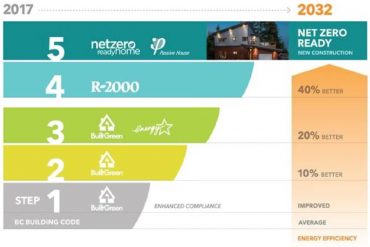
John Bleasby
Is B.C.’s Energy Step Code too much, too fast? (Part One)
Canadian ContractorTransparency, accountability and proven practice are absent, says VRBA head
As Canada marches towards a Net Zero Energy (NZE) future for new homes in 2030, many industry groups, housing organisations, and government regulators across the country look at British Columbia’s Energy Step Code with envy. Not Casey Edge. The CEO of the Victoria Residential Builders Association (VRBA), has been particularly outspoken and direct in expressing his views regarding the Step Code’s shortcomings. In a two-part exclusive interview with Canadian Contractor, Edge explains his position and proposes a more sensible path towards the province’s Net Zero Energy objective.
 What exactly is the ‘BC Energy Step Code’? According to the website hosted by the Urban Development Institute (UDI) Pacific Region, British Columbia’s Energy Step Code is, “a voluntary compliance path within the BC Building Code that establishes progressive performance targets (or steps) that support market transformation from the current energy-efficiency requirements in the BC Building Code to net zero energy ready buildings.” It therefore allows local jurisdictions to choose a level between one and five in terms of energy efficiency compliance, with current standards under the national building code as number one, and full NZE as five.
What exactly is the ‘BC Energy Step Code’? According to the website hosted by the Urban Development Institute (UDI) Pacific Region, British Columbia’s Energy Step Code is, “a voluntary compliance path within the BC Building Code that establishes progressive performance targets (or steps) that support market transformation from the current energy-efficiency requirements in the BC Building Code to net zero energy ready buildings.” It therefore allows local jurisdictions to choose a level between one and five in terms of energy efficiency compliance, with current standards under the national building code as number one, and full NZE as five.
While it might sound like a reasonable way to nudge the housing industry forward, Edge and his VRBA are not happy with key aspects of the code and the arbitrary manner in which it has been adopted by the province. It makes an interesting counterpoint argument.
You moved the Victoria Residential Builders Association away from the CHBA umbrella in 2013. Why?
A builder organization needs to be involved with builder activity. Because I have strong policy background, we are offering direct response to local issues. Sometimes that’s not always in tune with the provincial or national organization in terms of direction. We have a strong builders’ council that meets once a month to discuss the issues that they’re having in the field. I listen to those issues, and then I bring them to the local, provincial or national government.

Casey Edge, CEO of the Victoria Residential Builders Association
You see a strong link between regulations to make new homes more energy efficiency and home affordability.
The CMHC survey conducted a national housing dialogue about six months ago and released a report.
There’s absolutely no question that the number one issue for British Columbians is housing affordability. The average price of a house in BC is at least $100,000 more than the average house price in Canada. That is the dialogue. In certain niche circles, I think the dialogue is energy efficiency. However, amongst the average consumer in British Columbia it’s, ‘How am I going to be able to afford to buy a home?’
Yet Net Zero Energy is gaining a foothold in many places. Why is that?
When we hear that they’re building Net Zero homes in some regions at an affordable price point, that’s because of the land cost. They’re selling lots for $100,000, not up to $200,000 to $300,000. That $100,000 difference in land cost in BC is the cost of your Net Zero. This is a land issue. Promoting Net Zero when you’re getting your land for half the price of other jurisdictions, frankly that’s not very transparent.
What are your builder members telling you about the BC Step Code and NZE?
They’re already showing leadership through a program called BuiltGreen. And it’s market-driven. My builders tell me, “Casey, we can now build an affordable EnerGuide 80 home”, and they’re doing it. It’s above national code, it’s affordable, and it’s supported by proven practice. So we’re there, and we got there through a market-driven program, not through regulation. The Step Code changes are so far outside the national building code that it undermines the province’s relationship with the national building code, it undermines what a code standard is supposed to represent, and it undermines cost-benefit analysis which takes place at the national level, and therefore undermines consumer protection.
Many think the Step Code eases the way to NZE. What in fact is happening with the implementation of the Step Code at the builder level?
Right now you have municipalities that, in a negotiation [with a builder], will say. “We want, or we need some level of energy efficiency,” when negotiating a rezoning. Usually the discussion is over density. The developer says. “I can do that because I can make the numbers work.” That’s what is happening now. However, what the Step Code does is enable 160 municipalities to determine one of five levels of energy efficiency, not as part of a negotiation in terms of affordability and density and “Therefore I can make the numbers work”, but as a blanket, “You must build to this level.”
And this directly impacts housing affordability, in your view?
The government has created the housing affordability problem. They’re in control. In terms of the Step Code and government policy, what we’re saying is the government tells us what to build, how much we can build, where we can build through rezoning policies, how to build in terms of the building code, and how much money we have to give to the government in order to build through property transfer taxes, GST and so on. So how is the lack of affordable housing the responsibility of industry? I think what you’re going to find is a bit of a disconnect within the
industry. If you talk to the average builder in the field who has to earn a living building homes and marketing them, you’re going to get a different perspective.
Part Two of this interview next week.
Casey Edge has much more to say about how BC’s Step Code went wrong. He also offers some alternate suggestions for governments and regulators who are truly sincere in their desire to demonstrate energy-efficiency leadership.
Read Part Two of this interview: CLICK HERE
Follow John on Instagram and on Twitter for notifications about his latest posts


Leave a Reply